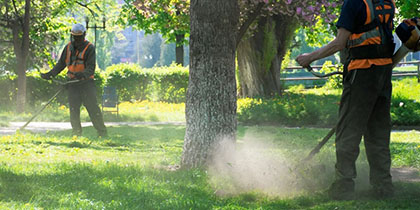Protect Yourself and Others During Landscaping Operations

It is easy to get too comfortable with a task and lose attention, skip steps, or assume that everything will be the same as the last time…until it is not, and then an “accident” happens. This is especially true with mowing and landscaping operations, which can seem redundant but have the potential for serious injury or property damage if important steps are missed. Recent labor statistics note that landscaping operations have almost five times the worker fatality rate of the average for all workers.1 To minimize this risk, consider following these “P-cautionary” measures:
Pre-inspect equipment
Routine service and maintenance should be part of the standard operating procedures to keep equipment in top shape, but damage and parts failures can occur between in-depth services. A visual and functional pre-inspection before putting equipment in use is the best way to ensure that critical safety features are in place and working to provide protection. This should include shut-off switches, emergency stops and barrier guarding that prevents access to moving belts, shafts, and blades. If the equipment is not safe to use it should be tagged “out of service” and locked out or disabled if possible.
Pre-plan
Whether it is a first-time job or one that has been repeated many times, taking the time to identify and address potential hazards and to plan out the workflow before starting a job can prevent injury, damage, frustrations, and delays. This may include identifying terrain and natural hazard issues (such as slopes, holes, debris, nests/hives, low or broken tree limbs, etc.) as well as pedestrian and vehicle traffic exposures. Developing a general checklist can guide crews on first-time and one-off jobs. Repeat jobs offer the benefit of documenting and improving the plan so that new crews can be well-prepared. Be sure to include loading and off-loading of equipment in the evaluation and planning.
Proper apparel/PPE
Landscaping operations combine the exposures of power equipment and outdoor work, each of which has its own considerations when selecting proper apparel and personal protective equipment (PPE). Be sure to consider the PPE needed to protect against flying debris, noise, rotating blades, sharp edges, hot components, and fuels/lubricants. A hazard assessment should be conducted to determine any PPE needed in addition to that specified in the equipment manuals. Work apparel should complement PPE and also be selected to provide adequate protection against outdoor elements such as heat, sun, humidity, wind, rain and cold. Working with PPE and outdoor-work apparel vendors can help to identify options that provide both protection and comfort, which will help to ensure proper use.
Point away
Powered mowing and landscaping equipment can spin at high speeds with enough force to eject debris such as rocks and sticks at speeds above 100 mph. This flying debris can result in severe injury and property damage. When maintained and operational, discharge chutes and deflector guards minimize this risk. Pre-planned mowing routes should ensure discharge areas point away from people, property, or ricochet hazards. A plan should be developed to capture or discharge grass clippings, so they are not discharged onto roadways or bicycle greenways, where motorcycles, vehicles and bicycles are exposed to the potential hazards.
Pause
It is important to continuously check the work area and monitor the equipment for changes, and hit the “pause” button if something seems off. When in doubt, power down the equipment and take a moment to verify if any corrective action is needed. When corrective action is taken, it should be documented. For example, if a lawn sprinkler head has leaked and caused a hole to develop, there should be documentation. This will also help avoid the impact of prolonged static postures and to ensure timely rest and hydration breaks, especially if heat or humidity levels are high. Heat, the noise of powered equipment, or getting lost in the task at hand can all lead to inattention. Use set reminders to pause and do a quick check. Heat index resources from NIOSH/OSHA are available in print and mobile applications to help identify when breaks should be scheduled to minimize heat-related risk.
Additional resources:
OSHA Resource Page - Landscaping Hazards
OSHA Resource Page - Heat Illness Prevention
1 Source: https://www.bls.gov/iif/oshcfoi1.htm#rates Note: Private industry includes all goods-producing and service jobs not in the public
